Despite the axe’s status as one of humanity’s most ancient and widespread tools, many modern preppers overlook the value an axe adds to a well-rounded survival kit. But that’s a mistake — we consider some form of an axe one of the four core bladed tools everyone should have on hand.
Axes are devastatingly effective against hard materials like wood and metal, exploiting the basic laws of physics and leverage to drive an edge through a surface with maximum force and minimum calories burned. This combination of effectiveness and efficiency makes an axe a lifesaver in situations as varied as escaping a burning office building to surviving the winter wilderness of the Pacific Northwest.
More: Not sure about all the different types of bladed tools and how to mix the right types together for your needs?
More: Survival hatchet review
A good axe can do a lot more than just chopping, though. If an axe has the right beard, poll, and handle design, you can “choke up” on it with your hand and use it for knife-type tasks like carving, game processing, shaving fuzz sticks, and similar fine work.
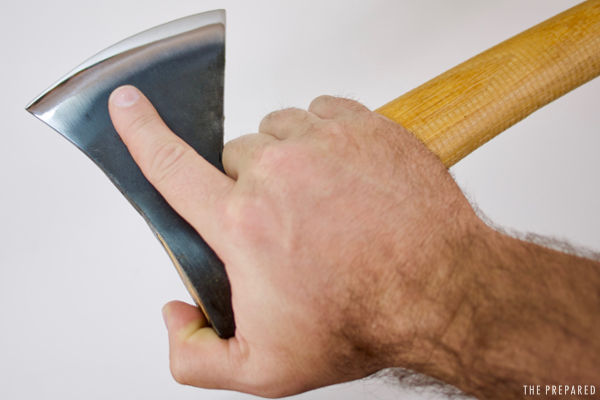
Sometimes the right axe actually works better than a field knife for certain fine cutting tasks, because the configuration pictured above places your hand and fingers very close to the working edge, giving you more control and allowing your sense of proprioception to engage in a way that it can’t with all but the smallest knives.
Full review details on the best survival axes, our criteria, contenders, and more below the fold.
If you just want to check this off your prepping list and move on without spending too much time or money, the jack-of-all-trades $80 Estwing Camper’s Axe is a heavy, steel-handled, ultra-durable classic with a great reputation. As a general-purpose survival axe from a reputable company, the Eastwing is a capable chopper that works for any type of user (skilled or unskilled) in any environment (country, suburbs, or city).
The $235 Gransfors Bruks Small Forest Axe is a legendary axe that has dominated the compact survival axe niche for decades and is widely known by the acronym “SFA.” You pay a little extra for the name, but this amazing tool is worth the premium. At only 19 inches and two pounds, it’s small enough to toe the line of being a hatchet, but gives you that axe-level power in a package you can easily carry on foot.
The very best emergency axe for city preppers is the tried-and-true $240 Fire Axe Inc JP Special 4lb Pick Head Axe with synthetic handle. Expensive, but worth it: The JP Special is a high-quality axe carried by firefighters and frequently recommended in firefighter forums because it’s a dependable beast of a chopping, breaching, and demolition tool. Because this is a personal axe and not a truck axe, it’s compact enough (though just barely) to be carried short distances on a belt or pack.
The $180 Hults Bruk Kisa Medium Sized Felling Axe is right in the sweet spot of quality, features, size, and price for an axe that’s built for processing large amounts of forest wood. It’s large enough to handle tough homesteading tasks but small enough to carry a while on foot if you needed to. Hults Bruk is a legendary brand popular among bushcrafters and preppers.
If you’d rather have just a little bit more portability in an axe that’s still capable of handling rural tasks, check out the slightly cheaper $150 Helko Journeyman. However, the Journeyman’s head shape is more suited for wood splitting than it is for knife-type work like carving.
The best budget axe for rural preppers is the $50 Council Tool 2.25# 24” Boy Axe. Made in the US (which is harder to find the cheaper you go) and based on a famous design used by the US Forest Service. You’ll sacrifice fit and finish, plus it’s meaningfully longer and heavier than the more expensive alternatives, but it will serve you well in a pinch.
Why you should trust us
I’ve professionally reviewed bladed tools for 6 years, personally used them in the bush for 35 years, and have been a prepper for 10 years.
We’ve spent an additional 55 hours preparing this review by talking with other experts in the field — ranging from firefighters and first responders to bushcrafters and preppers — and researching countless product reviews and social forum threads.
Top contenders and our selection process
We narrowed down the field to the top 20 survival axes of different sizes and features. From that list we received samples from top manufacturers to compliment the models we already owned.
Any of the axes in the top 20 will serve you well in any type of emergency, but we’ve narrowed down the list further to the ten best picks for different types of preppers in different environments.
View the spreadsheet in Google Docs
Note that axe data, particularly weights, are often wrong or misleading on ecommerce sites. For example, many sellers only list the weight of the axe head, not the overall axe. Where possible, we’ve used data directly from the manufacturer or from speciality retail sites that take care to get it right.
We’ve focused here on more lightweight, packable axes that are big enough to do useful felling work but small enough to carry on-foot for modest distances.
Our final choices come from a mix of reputation and reviews from other experts we trust, combined with our own hands-on experiences with many of these products and brands.
Table of Contents
- Axe basics
- Survival axe considerations
- Don’t plan to fell big trees in a disaster
- Best axe for most people: Estwing Camper’s Axe
- Overall upgrade pick: Gransfors Bruks Small Forest Axe
- City and suburbs upgrade pick: Fire Axe Inc JP Special
- Best overall rural axe: Hults Bruk Kisa Medium Felling Axe
- Also great for rural preppers: Helko Journeyman
- Budget pick for rural preppers: Council Tool 2.25# Boy’s Axe
- More info about axe brands
- Axe safety
Axe basics
Axes are two simple machines put together: a wedge and a lever. All the members of the axe family (including hatchets and tomahawks) share the same basic anatomy:
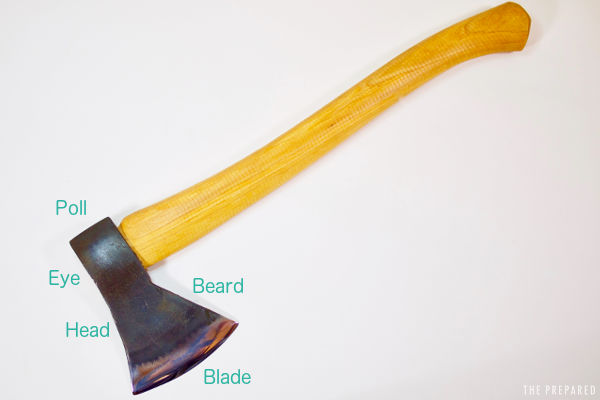
- Head: The wedge-shaped weight at the top of the axe that does the chopping.
- Eye: The large hole in the head that attaches around the handle.
- Blade: The part of the axe head with the edge on it that does the chopping. Sometimes called the ‘bit’.
- Poll: The part of the axe head opposite the blade.
- Beard: The part of the blade that extends downward in a triangle shape.
Survival axe considerations
Weight distribution
An axe is more effective when most of the weight is in the head. When the weight is more evenly distributed between the handle and head, the laws of physics make it less “punchy”.
So when you’re comparing models, keep in mind that two axes with the exact same length, materials, and weight can have very different chopping capabilities.
Head shape
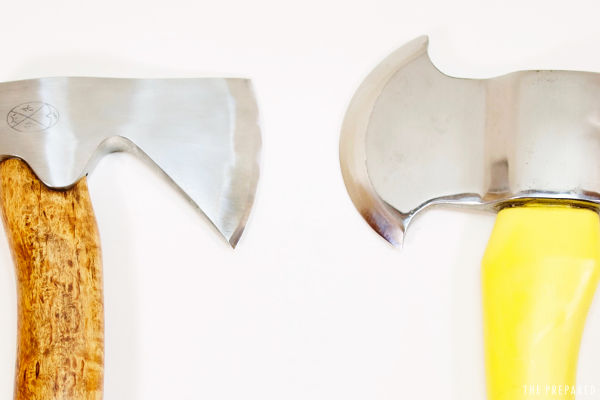 The edge shape and thickness determines how well an axe handles different materials.
The edge shape and thickness determines how well an axe handles different materials.
A flatter edge shape puts more of the edge in contact with the thing being chopped on each stroke, making it great for wood and other natural materials.
But that same flat edge could more easily get stuck in a totally flat surface (like a wall or door), which is why some demolition or “fireman’s” axes have half-moon shaped heads.
Those curvy edges can be awful to chop rounded natural materials with, though, which is why this factor matters when thinking about your environment.
Head thickness and cutting vs. splitting
A wide axe head (think of a “fat” pyramid) is better at using that wide angle to forcefully split pieces apart. Like splitting already-cut logs of firewood into sections: a fat wedge forces the wood apart through opposing pressure, more so than biting into the material and slicing through it.
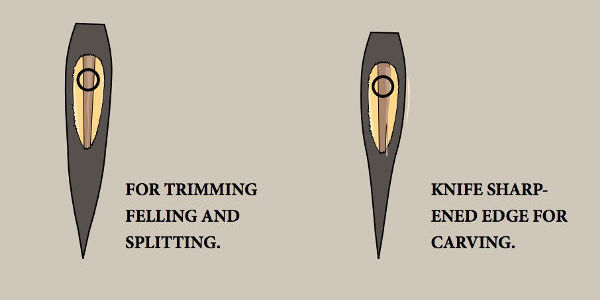
A thinner axe head acts more like a knife cutting through the material, and is better suited to cutting tasks like felling trees or limbing logs.
We generally prefer the more cutting-oriented heads that are more popular with today’s bushcrafters for their versatility in doing many different kinds of non-chopping camp chores, but for most preppers the real-world performance and usage differences between the different head thicknesses and shapes represented in this guide are subtle and not worth obsessing over.
Poll shape
You can flip an axe around and use the poll as a secondary tool.
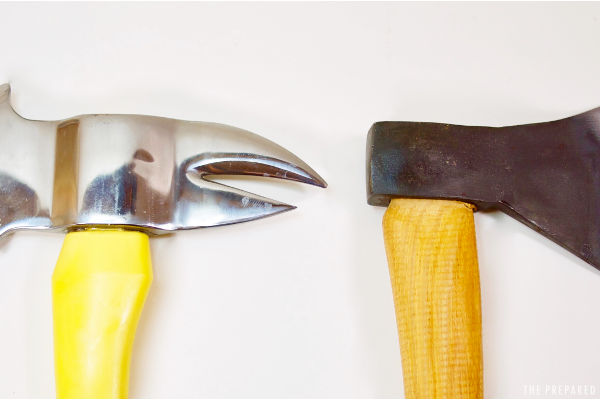
Polls come in two varieties: hammer and spike. There’s also a ‘pick’ axe poll, but in this guide we use ‘spike’ and ‘pick’ interchangeably since they’re basically the same thing.
Hammer polls allow the axe to double as a hammer. They’re also generally safer than spike polls. There is some folklore around not using an axe poll as a hammer, but these concerns are vastly overrated. Lightweight striking is fine — it takes a lot of beating against a hard surface to deform the eye of a good axe, so go ahead and hammer those tent stakes and forget about that myth you read on the internet.
The spike or pick poll increases the axe’s effectiveness as a demolition and breaching tool, which is why you see this feature on tomahawks and dedicated breaching axes. A spike poll can also be used for digging, and is especially good at digging through hard or rocky ground.
Handle length
The mechanics of leverage means the length of the handle matters a lot for how well an axe chops. Even an inch can make a difference.
That creates a tricky tradeoff between portability and chopping ability. We favor a balance between these two factors and it’s reflected in our recommendations.
But if you were looking for a big, old-growth hardwood chopper that’ll never leave your garage, for example, you’d clearly want a longer handle.
Some handles are meant to break and be replaced
Like tires on a car, a wooden axe handle is a wear part that is designed to break down with use and be replaced periodically. Axe handle breakage is a normal thing for well-used axes, which is why hardware stores stock so many wooden replacement handles.
Breakage is also a factor for fiberglass handles that are rated to handle 1,000 pounds or more of lateral force. But it normally takes some abuse to get there.
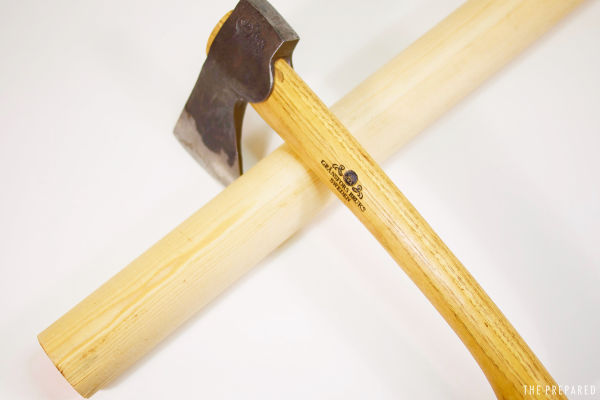
Overstrike is a major cause of breakage for wooden and synthetic handles — especially among amateur users — and will take this valuable tool out of commission until repaired. Overstrike happens when you swing the head too far out and the part of the handle right beneath the head whacks into the log.
Common handle materials
Wood:
- Pros: light, absorbs shock well, and is infinitely replaceable with a little effort.
- Cons: easiest to break or splinter.
Synthetics (mostly fiberglass):
- Pros: lightweight, very strong, good shock absorption.
- Cons: very difficult to repair or replace.
Metal:
- Pros: strongest, lets the axe double as a pry bar.
- Cons: very heavy, transmits shock right to your wrists and arms.
We take those tradeoffs into consideration when thinking about urban vs. rural and skilled vs. amateur preppers. For example, if you live far away from the woods or if you have no idea how to go about fashioning a replacement axe handle, then you might pick a synthetic-handled axe and hope it never breaks.
Don’t plan to fell big trees in a disaster
For every prepper who’s within bug-out distance of a forest, chopping wood for fire and shelter is a necessary and appropriate part of surviving.
But “chopping wood” does not equal “chopping down trees with an axe.” The former is essential, while the latter is a very bad idea for anything but the smallest trees — unless you’re already experienced enough that this guide is pointless.
Felling trees is far more dangerous than it looks, especially with an axe (regardless of axe size). No matter how easy it looks on YouTube, you should not attempt to fell trees that are larger than about half a foot in diameter.
It’s also the case that even with chainsaws and trucks to haul wood in, it can take weeks to prepare enough firewood to heat a cabin for a full winter in any geography where it gets really cold. With axes it can take part of a summer, and that’s if you already know what you’re doing.
If the situation absolutely requires you to fell a tree, and there’s just no getting around it, then you should use a saw — preferably a chainsaw. This is still quite dangerous, but it’s less insane than an untrained axe user wailing away on a large tree.
Best axe for most people: Estwing Camper’s Axe
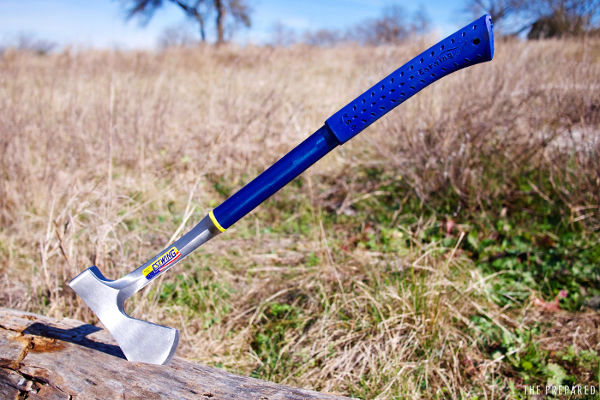
- Price: $$
- Specs: 26” length, 3.4 lbs weight, all-steel construction, shock-absorbing handle, general-purpose head shape
- Pros: indestructible, great brand reputation, widely available, inexpensive
- Cons: heavy, low splitting ability for the weight
Who should buy this: The $80 Estwing Camper’s Axe is ideal for anyone who lives in a city or suburb, where space is at a premium and they may have to chop materials besides wood.
It’s also good for someone with little or no experience using an axe, who will be prone to overstrike and other axe abuse that could quickly break a wooden or synthetic handle.
At 3.4 pounds, this axe is heavier than the more expensive alternatives, making it less preferable long on-foot bug outs. But it works well for bugging in, vehicle bug outs, or shorter on-foot trips.
If you want to optimize and specialize for a specific environment, activity, or skill level, then you can do better than the Estwing — but for affordable value and all-around flexibility, it’s impossible to beat and will last you a lifetime.
Benefits: The Estwing’s all-steel design makes it strong enough to withstand serious abuse like hard hammering or overstriking, so it’s forgiving for unskilled or fatigued/injured users.
This axe is compact enough to be easily stored in a closet or under a bed, or fit into a pack for short distances. It’s tough enough to be used to hack through a door or wall. The hammer poll can be used for striking in a pinch.
The Estwing’s head shape and edge profile are along the lines of a Hudson Bay pattern, but it’s very thin. The thinness gives it plenty of bite in our own testing and makes it a very capable cutter despite its poor weight distribution. But it will stick in wood and is not wide enough for serious log splitting.
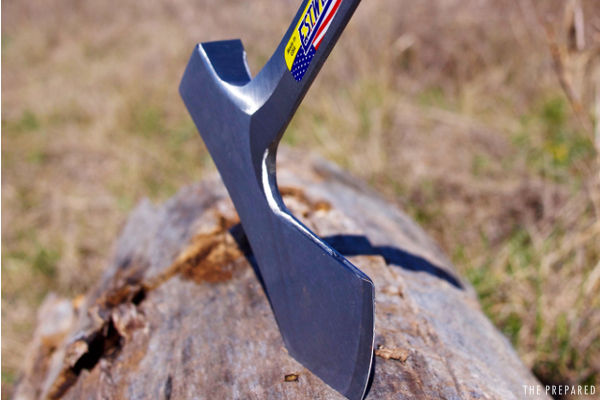
The large beard means you can choke up on it for carving and slicing and get your hand behind the edge — but the thin, diamond shape around the edge makes this uncomfortable. So this is not a general-purpose bushcraft axe, and is not popular with bushcrafters.
The handle steel is relatively soft to help with toughness and shock absorption, but it means you can bend the axe if you attempt to pry with it. But it can be beat back into shape if that happens.
Downsides: The Estwing’s all-steel construction has three main drawbacks: lack of shock absorption, poor edge retention, and poor length-to-weight ratio. The first downside affects comfort and fatigue, and the latter two affect performance.
The steel handle transmits the shock of axe blows directly to the user’s wrists and arms. This increases fatigue when using the axe for long period. The shock-absorbing handle and softer steel help with this, somewhat, but it’s still an issue.
The ductile steel that makes the handle of this axe so tough also makes the thin, V-grind edge more quick to roll and dull than the harder, convex edges of the other axes in this guide.
The Camp Axe’s overall length is much shorter than competing wood-handled axes in the ~3.5lb range, which also reduces chopping ability by reducing leverage.
In short, this axe gives up some efficiency and portability (despite its compact size) in exchange for its incredible, amateur-friendly indestructibility.
Brand and product reputation: Our research and first-hand experience with Estwing axes indicates that this American-made brand has a sterling reputation with campers, construction workers, preppers, and outdoorsmen. We have found no significant complaints about the quality of Estwing products and consider this to be a very reliable family of tools.
Overall upgrade pick: Gransfors Bruks Small Forest Axe
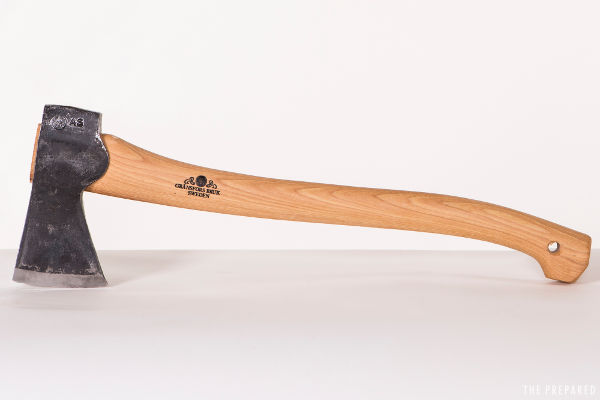
- Price: $$$$
- Specs: 19” length, 2b weight, hickory handle, hand-forged carbon steel head
- Pros: unmatched reputation, iconic bushcraft and camping tool, excellent for cutting, carving, and general bushcraft chores
- Cons: less suited for splitting, you pay a bit extra for the brand name
Who should buy this: The $235 “GB SFA” is the best compact survival axe for pack-weight-conscious preppers in the hardwood, arboreal forests of North America. This is also for preppers who want to buy the reigning champ and enjoy the resulting peace of mind from knowing you’ve got a premium tool with legendary status and celebrity endorsements.
Benefits: At 19 inches long and only 2 pounds in weight, the SFA is really more of a large hatchet than an axe, with a head that’s optimized more for cutting than splitting (thought it does split), and that can be very effectively choked up on for use in place of a knife for carving, slicing, food and game preparation, and other fine cutting chores.
The SFA is so effective at general-purpose cutting tasks that some bushcrafters who use one prefer it to the fixed-blade field knife for everything but batoning.
Downsides: The Gransfors price premium is the only downside peculiar to this axe, and it’s not nearly as high on this particular model as it is on some other axes in the Gransfors line. Any other downsides of the SFA are shared by their similarly-compact competitors — namely, the compact size reduces chopping ability and user safety compared to a full-sized axe.
Brand and product reputation: This amazing tool is the gold standard in this space, even to the point of being an important part of the cultural history of axes. Note the outsized popularity of this brand and model — thanks in part to an endorsement by famous bushcrafter Ray Mears — has created an online backlash by people who automatically dislike something so popular. Ignore them.
City and suburbs upgrade pick: Fire Axe Inc JP Special
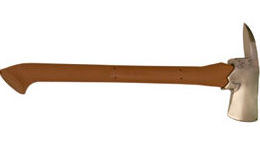
- Price: $$$$
- Specs: 28” length, 4lbs weight, 1200lb-rated fiberglass handle, forged and chromed carbon steel head
- Pros: indestructible, great brand reputation, premium professional demolition tool
- Cons: heavy, better for demolition than wood chopping
The $240 Fire Axe Inc JP Special 4lb Pick Head Axe is perfect for escape, rescue, demolition, and B&E in urban environments. Even though you might end up chopping down trees in Central Park, our top choices for people in developed areas are based on a handling a wide mix of materials and activities.
And when we have to choose between axes great for chopping wood vs. anything else, in this category we optimize for more urban needs like navigating damaged buildings, breaking into locked rooms and containers, making access holes for ventilation or surveillance, or busting up furniture for firewood.
Note: The above link takes you to the Fire Axe Inc JP Special with a wood handle (item# JPSW). The same axe is available with a fiberglass handle (item# JPSF) for the same price, but you need to contact the company and ask for that specific model.
Benefits: The heavy, chrome polished, carbon steel head will chop right through nails, wiring, and other tough industrial materials without taking damage.
But it’s still capable of chopping wood. Although if you’re using it on trees, the blade’s width and shape make it much better for splitting than cutting.
The pick on the back of the head is used for creating holes in sheetrock or wood, and lets the axe operate as a pry bar to force open doors and windows.
The 1200-pound rated fiberglass handle is light yet strong enough to pry with. The low weight of the handle, when combined with the heavy head, makes the axe a devastating splitter despite its short length.
Downsides: The main downside to this axe is the weight. At four pounds, it’s intended to ride for short distances on the belt.
The pick head also prevents it from easily being used as a hammer, although you can hammer with the side of the head if you have to.
The blade profile and ergonomics make it unsuited for common bushcraft tasks that involve fine work, so it has to be paired with a field knife for those jobs.
Brand and product reputation: This axe is commonly recommended on firefighter and first responder forums as an aspirational product, i.e. a speciality, premium tool that you spring for when you’re serious about your work, and that you carry with pride and plan to hand down to your children.
Because this is a niche product carried at speciality outlets, there aren’t many traditional product reviews of it, but all the discussions of it we’ve read are highly positive with no reports of flaws or quality control problems.
Best overall rural axe: Hults Bruk Kisa Medium Felling Axe
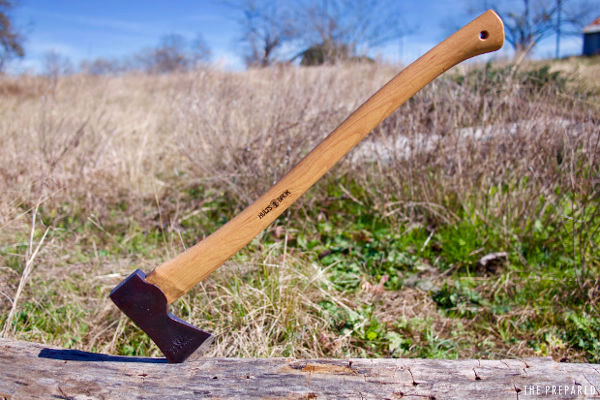
- Price: $$$$
- Specs: 26” length, 2,86 lbs weight, 2lb head weight, linseed oil-treated hickory handle, hand-forged carbon steel head
- Pros: legendary brand reputation, premium bushcraft and camping tool, more of a cutter than a splitter
- Cons: none that are particular to this axe
Who should buy this: The $180 Hults Bruk Kisa Medium Sized Felling Axe is a great choice if you live in a rural area, especially in northern areas with hardwood forests, but still care about portability.
Note that none of our rural axe recommendations are on the full-sized end of the spectrum — the very largest axes used by lumberjacks solely to fell large standing trees — because in any case you want it to be portable enough to move on foot if you really need to.
Benefits: The 26-inch Kisa axe is a bit shorter and more lightweight than would be ideal for a straight tree-felling axe. In return for not going overboard into full-sized tree felling axe territory, you get a compact axe that can do everything you’ll need an axe to do in the woods.
At 2.86 pounds, we’d consider it packable for modest distances, and many bushcrafters actually carry this axe (or one this size) as part of their standard loadout. For some experienced bushcrafters, the Kisa is the “one blade” they’d want with them in the woods.
The head is a traditional pattern that works for both cutting and splitting, but is a little more optimized for cutting. It’s easy to choke up on the head for use in non-chopping bushcraft tasks like fuzz stick making and carving. The poll can be used as a hammer in an emergency.
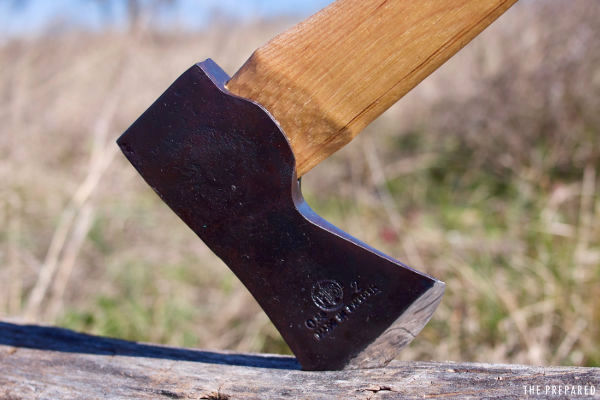
With the Kisa, you get a hand-forged, Swedish axe from one of the world’s oldest and most reputable axe makers, and it offers the same quality and features as the comparable $245 Gransfors Bruks Scandinavian Forest Axe at a lower price point.
Downsides: Any downsides this axe has are shared by all axes in this category, e.g. the wooden handle will break eventually, and the size and weight make it less portable than more compact axes or hatchets. But we’re aware of no downsides particular to this axe.
As with all quality wood-handled tools, you’ll want to store this axe indoors when possible — it’s not something to throw in your truck bed.
Brand and product reputation: This axe model is very popular with bushcrafters, and gets rave reviews in forums, on YouTube, and at retailer sites. Hults Bruk’s reputation is legendary, and we’re not aware of any criticisms of their quality control.
Also great for rural preppers: Helko Journeyman
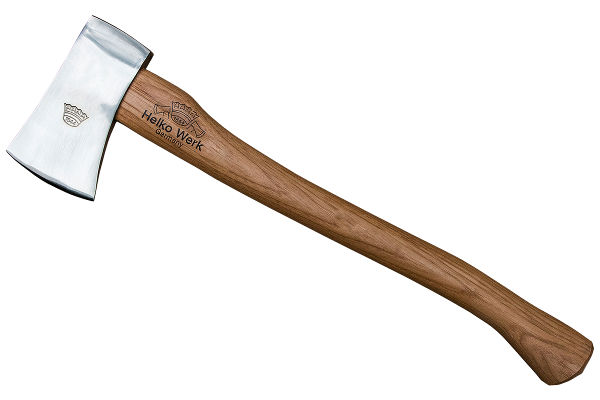
- Price: $$$
- Specs: 20” length, 2.2 lb weight, 1.5 lb head weight, Swiss-made hickory handle, hand-forged carbon steel head
- Pros: great brand reputation, premium wood processing tool, equally balanced between splitting and cutting abilities
- Cons: less suited for non-chopping bushcraft work
Who should buy this: Pick up the $150 Helko Journeyman instead of the Hults Bruk Kisa if you want something that’s more portable but still good at processing hardwood.
Benefits: The Journeyman’s head shape strikes a balance between cutting and splitting ability, making it a versatile camp axe for creating fire and shelter. The head has a mirror polish to reduce getting stuck in wood and that resists rust from natural moisture. The poll is safe to use for light hammering, since the maker has explicitly designed it for such use.
Downsides: This axe’s head shape makes it a bit less ideal for carving and other knife-type work. So you’ll want to pair it with a good field knife for non-wood-processing chores.
Helko axes often don’t have quite the same hand-finished feel as the Hults Bruk axes — which might be part of the reason the competitive HB Kisa is $10-20 more — so keep that in mind if you care about aesthetics and your tastes lean more towards the traditional, rustic vibe.
Brand and product reputation: Helko is relatively obscure in the US (outside of axe-nerd circles) compared to the major US and Swedish makers, so English-language reviews of this specific model are rare. But we’ve found no complaints about the brand, and this product’s reputation is top-notch in all the sources we reviewed.
Budget pick for rural preppers: Council Tool 2.25# Boy’s Axe
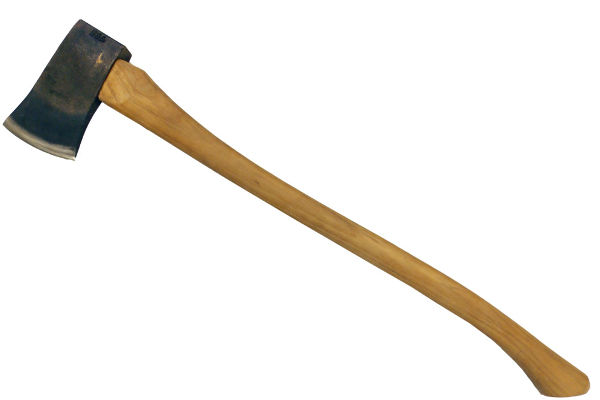
- Price: $$
- Specs: 24” length, 3.5lb weight, 2.5lb head weight, hickory handle, hand-ground carbon steel head
- Pros: legendary brand reputation, quality wood processing tool, balanced between splitting and cutting abilities
- Cons: none that are particular to this axe
Who should buy this: If you want an axe specialized for rural needs but want to spend less than $100, check out the $50 Council Tool 2.25# 24” Boy’s Axe.
Benefits: The CT Boy axe is a budget offering from a premium maker, which we prefer over products made by purely budget manufacturers like Snow & Nealley. This is a well-tested design that’s based on an axe used for years by the US Forest Service, and it’s similar in size and shape to an axe preferred by bushcraft legend Mors Kochanski.
Downsides: The finishing on this is rougher than on the company’s premium lines, and the poll and eye walls aren’t hardened to support hammering. But it’s unlikely that most preppers will really notice much difference if they aren’t comparing this axe side-by-side with a premium offering.
This is a splitting and cutting axe, and not as much a general-use bushcraft/carving axe that can substitute for a field knife.
Brand and product reputation: Council Tool’s offerings are widely considered to be on-par with the best European makers, and in some cases a cut above. We have read about cases where buyers of axes in the company’s budget lines have gotten products with handle issues, but the customer service is outstanding and returns are handled professionally.
The competition
Outside of our top contenders, there’s a whole secondary group of great axes that might fit the specific price or features you’re looking for:
Snow & Neally Hudson Bay ($68): A popular American-made pick for budget compact bushcraft axes. The length and weight is typical of the classic Hudson Bay pattern. In fact, if you want to get as close as possible to the specs of the Gransfors Bruks Ray Mears Wilderness Axe, then this S&N axe is a very close match at a far cheaper price.
Wood Tools Bushcraft Axe ($63): This is a new one to us, but we got a sample and we absolutely love it. This wonderful little hand-ground axe is designed on the model of the perpetually out-of-stock Ray Mears Gransfors Bruks axe, but a bit lighter and shorter. This axe is clearly a labor of love from a boutique shop that, in our opinion, is criminally underpricing its work. We’ve used this axe in a number of pictures in this guide, including the main guide image at the top of the article, so if you like what you see then hurry up and order one before the maker figures out what’s up and doubles the price.
Helko Rheinland Pack Axe ($150): This is a beautiful, bushcraft-focused axe from Helko. It’s along the same lines as the Wood Craft Pack Axe from Council Tool, in that it’s a relatively recent, premium, retro-styled offering aimed at the bushcraft crowd. It’s designed to be lightweight and packable, and to work for carving and other bushcraft chores. Unlike all the other axes in this guide except for the Mueller axe, the axe head shape is a very traditional German all-purpose woodworking pattern. At least one expert review we’ve seen claims that fit and finish on this axe is not quite as good as competing Swedish offerings, but in terms of performance no one disputes that it can hold its own.
Helko Scout ($165): The Scout is a great cutting and splitting axe for preppers who care less about portability and more about getting through lots of wood more efficiently. Between the head weight, handle length, and head shape, this is a better high-volume wood processor than the more cutting-focused axes like the Hults Bruk Kisa, but is not as suited for use as a knife alternative for fine bushcraft work.
Hultafors Classic Hunting Axe ($130): The Hultafors-branded axes aren’t available in the US, so our European readers should give this compact bushcraft axe a very close look.
Hults Bruk Aneby ($160): This is as close as you can get to the Hultafors Classic Hunting axe in the US, and like the Classic Hunting Axe it’s a fine alternative to the Gransfors Bruks Small Forest Axe (SFA).
Ray Mears Gransfors Bruks Wilderness Axe ($175): This famous axe model was designed by Ray Mears, as a midpoint between Gransfors Bruks’ Scandinavian Forest Axe and their Small Forest Axe. It’s never in stock, but if you do score one it’s a wonderful tool. You’ll pay extra for the names on it, though.
Helko Black Forest Woodworker ($160): This is Helko’s flagship product, a beautiful, traditional design that fills the same general-purpose wilderness axe niche as the Gransfors Scandinavian Forest Axe. It has a head that’s slightly heavier than other axes in this size range, and based on overall design it’s a very good general-purpose bushcraft and survival axe.
Council Tool Wood Craft Pack Axe ($155): This axe was recently introduced, and has a ton of features aimed at the bushcraft and survival crowd. The hardened eyewall and poll are designed for hammering, and head shape is made for a mix of cutting, carving, slicing, and general camp use. It’s often out of stock, and some reviewers claim the overall fit and finish level on this model is higher than that of even the premium European axe makers.
Council Tool Velvicut Hudson Bay ($145): The Velvicut line is one of Council Tool’s two premium axe lines, which makes this the axemaker’s best Hudson Bay pattern offering. If you want a traditional Hudson Bay type axe, then this is the top of the line.
Gransfors Bruks Scandinavian Forest Axe ($245): The larger alternative to the Gransfors SFA, this iconic axe has played a major role in the revival of the premium axe scene in the US and Europe. These axes are very hard to come by online right now, and if you can find one in stock it may have a significant markup.
Snow & Nealley Single Bit 2.25# ($80): A budget wood chopper from a solid US axemaker, consider this an alternative to the Council Tool Boy’s Axe of the same size.
Mueller Biber Classic Forest Axe ($150): This axe is similar in shape to the Helko Rheinland Pack Axe, but it’s much larger. It’s a traditional German axe from an established, boutique Austrian maker, and the quality is impeccable, especially for the price.
More info about axe brands
Hultafors is one of the two top-tier Swedish axe makers that still runs its own factory (the other is Gransfors Bruks), and the products are popular with bushcrafters for their high quality and outstanding value. Hultafors axes are fully hand forged, and generally come in two finishes: a cheaper, standard finish and a more expensive, premium finish.
Hultafors also owns Hults Bruk, and axes from both brands come from the same foundry. There are some differences in labeling and branding, depending on the year, but you should consider the two brands as equivalent and just look at the specifics of the model.
Gransfors Bruks is a high-end maker of fully hand-forged Swedish axes. Thanks to a combination of craftsmanship and celebrity bushcrafter Ray Mears’ endorsements, GB has become the bushcraft community gold standard. You pay a premium for the Gransfors Bruks name, though it’s not always clear that the quality difference is worth the price difference over the other top makers — you have to evaluate on a case-by-case basis. But if you can afford to ignore the price difference, and you just want the fan favorite, then this is your axe maker.
Wetterlings is a venerable Swedish axe maker now wholly owned by Gransfors Bruks, and the latter has stopped making axes under the Wetterlings mark as of 2017. If you find a Wetterlings axe for sale it’s usually of very high quality, so buy with confidence.
Snow and Nealley is an Amish axe maker that has been based in Maine since the late 1800’s, and they’re still turning out high-quality, traditional wood-handled axes at unbeatable prices. Many of our budget picks are from this maker. The axe heads were briefly made overseas, hence a smattering of negative reviews that claim they’re made in China or Mexico, but they’re back to being made in the US out of US-sourced steel and hickory.
Estwing is an American tool maker familiar to many from big box retailers, and they make very good axes at budget prices. The Estwings’ all-metal construction — even the handle is metal — is a strength and a weakness. These axes are much heavier than their wood- and synthetic-handled counterparts, but are bombproof.
Council Tool is based in North Carolina, and the company’s premium Velvicut and Wood-Craft lines are on par in price and quality to the top European makers. Their budget axes have differences in tempering and finish from their premium line, but are still quite good. They made axes for the National Forestry service for a while, and have a sterling reputation among axe enthusiasts.
All the Council Tool axes are drop forged, which means that the blacksmith holds the heated metal with tongs while a machine hammers it. So they’re sometimes billed as “hand forged,” and this is accurate for some definition of the term, but they’re not hammer-forged like a Hults, Gransfors, or Mueller, so they don’t have quite the same aesthetics.
Helko is a German maker of fine, traditional axes for forestry and woodcraft. Their offerings generally compare in price, quality, and features to the top Swedish and American makers. Helko’s axe heads are drop-forged, like those of Council Tool.
Husqvarna is a chainsaw maker that is now in the budget axe business. The company sources its axe heads from the Hults Bruk factory, and for this reason many people on the internet who don’t know how quality control, steel selection, finishing, and tempering work have concluded that the heads must be therefore be identical to Hults Bruk/Hultafors heads. This is trivially false, as even different lines from the same maker will have different steel, tempering, and quality variances.
We haven’t included any of Husqvarna axes in our guide because the reviews are so mixed — people either love their axe or they hate it because they’ve broken the head in half. But we did want to mention this brand in order to debunk the myth that you can get a Hults Bruk head on the cheap by buying one of these budget axes and doing some of your own finishing work on it.
Mueller is a small, family-owned Austrian company that has been making axes continuously for over 300 years, and their reputation is excellent. They aren’t as widely known in some of the other high-end makers, but their price and quality are considered on par with the best. Their axe heads are fully hand forged.
Axe safety
There’s an old saying: “You can’t spell accident without axe.” Yeah, the spelling doesn’t work, but you get it. Axes are dangerous. Watch some videos and heed these tips:
- Always use two hands.
- Set up a dedicated safe area free of rocks, hazards, and (most importantly) other people. Nobody comes near you while you’re swinging an axe.
- Always position yourself so you’re out of the path of your swing if you miss your target and it keeps going. Sometimes this will feel awkward and inefficient, but do it anyway.
- Aways swing so that if the axe glances off the wood it won’t hit your body with the edge. Again, this may make your swing suboptimal, but it’s even less optimal to end up with an axe in you.
- Always make sure your axe is sharp. Learn the best ways for preppers to sharpen blades.
- Always carry your axe with the blade pointing toward the ground.
- Never use your axe when the head is cold, because it will be more brittle and likely to chip. If it’s winter, then warm the head up by a fire or by placing it next to your body before using it.
Notice that two of these safety rules are about how you position your body in relation to your swing. This is hard to get right, and it’s where most people have accidents.
In general, a shorter handle takes more care to be safe with than a longer handle, because the head swings that much closer to your body and vital organs.
It also matters how long your arms are and how tall your body is in relation to the axe’s length, so a shorter axe can be safer for a smaller person. Think about this length vs. safety factor when you’re selecting and using an axe, because all that sweet portability you bought by going with a 19-inch pack axe does you no good if the edge ends up buried in your leg.











































